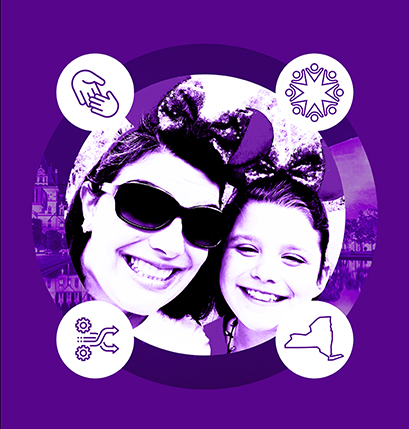“It was an instant spark. I immediately knew the student who I wanted to teach.” Katie Miller described the moment in her previous career when she realized she was destined to teach students with disabilities.
“I was working in Albany for a general education development [GED] test preparation program. My students needed extra support with workforce and life skills.” Katie was fond of the young adults she met. She knew how to connect with teenagers and she liked supporting students who may require different interventions.
Katie worked directly with people in a variety of experiences prior to the GED program. She worked with adults who had traumatic brain injuries; supported employment readiness skills for adults; and even taught in a Head Start program, which serves children ages birth to five. All of these experiences led Katie to the NYU Teacher Residency, where she sought a secondary education degree as a special education generalist.
“The same day that spark went off while at the GED program, I saw an ad for the Teacher Residency. I knew I had to pursue it!” From that day forward, Katie worked toward her dream of becoming a teacher.
Special education and community
Katie always felt destined to teach, but she described two major barriers that stood in her way. “I never had the money. I couldn’t justify no job and no income while getting a teaching degree.”
The other barrier was emotional and personal. “My ex-husband made me believe I was too stupid to do anything. This really impacted the way I saw myself.” But Katie, steadfast in her dreams and determined to give her daughter a good life, filed for a divorce and never looked back.
“Finding the Teacher Residency was everything I needed. To be able to work in a school, have an income, and work toward a master of arts in teaching, was the perfect model for me and my family.”
Katie wanted to impact her community – another reason the Teacher Residency was so attractive. She could continue to give back to the Albany community that she had grown close to in her previous jobs. Katie often found herself lifting up people who had disabilities and who were not supported throughout their schooling. She witnessed the need to start earlier – to support students in high school before they fell through the cracks.
“It’s really interesting to consider if I had gone into teaching after receiving my bachelor of arts at Syracuse University. I would have ended up in a suburban school, and I would have hated every single day. It took me time to find my ‘kids,’ but I am so glad I did. I belong in Albany teaching special education.”
In Katie’s prior roles, the support she provided – including helping people apply for Medicaid or food stamps – led to her deep understanding of the ways poverty affects families. This knowledge helps her support access initiatives in her school and surrounding community. “We all must understand our community and our students. If a student is eating breakfast in class, it may be because there’s little food at home. It’s our job to know these things.”
A connection to community is essential for Katie, and she believes it is also essential for all teachers. She offered new teacher residents some advice: “Walk the streets. Walk the halls of the school. Learn about the history of the community and school. All of this helps you understand the funds of knowledge from a community and appreciate where you teach.”
Special education and hands-on learning
The Teacher Residency gave Katie the hands-on experience that she needed to feel confident. While she had some experience with people who had developmental, social, and intellectual disabilities, the mentoring and cohort model in the Teacher Residency proved priceless.
“I was really lucky to be paired with my mentor teacher Pete Justice. He’s very well connected in school. When I was working alongside him, he would push me to try new things and encourage me to watch other teachers – besides him – teach.”
She described how Albany has an extensive co-teaching model. Students with disabilities and general education students are usually in the same room, and that’s how she worked with Mr. Justice. She also experienced a self-contained classroom with students who had multiple learning challenges.
Through the work with her peers in the Teacher Residency, Katie learned about the design of special education services in other school systems. “The cohort gave us really good connections to other schools and how they support students. It provided insight to special education instruction in different parts of the country.”
Even a year out from the program, former residents still share with, and look to one another for resources. “It’ll keep improving my practice,” affirmed Katie.
Special education and relationship-building
All teachers must find ways to connect with their students. Because she only sees some students a couple times per week, Katie recognizes how crucial that connection is for students with disabilities.
“No learning can happen if they don’t like you. I have to make sure I have a relationship with each student. This starts with simple things like learning to say their name correctly, relating to them, and being friendly.”
Students with disabilities are all so different, and their needs are not the same. “It is really eye-opening,” explained Katie. “I have to continue to try new approaches and learn about what works for certain disabilities.”
With a strong sense of what she overcame personally and professionally, Katie continues to progress in her teaching and recall lessons from the Teacher Residency. The importance of community drives her, and she is dedicated to making a difference in the lives of her students.
The relationships with her mentor teacher, cohort of peers, and residency director are an inspiration and a resource. “I have the skills and the resources that I need to help my students. I achieved my dream, and I want my students to have the same opportunity.”
